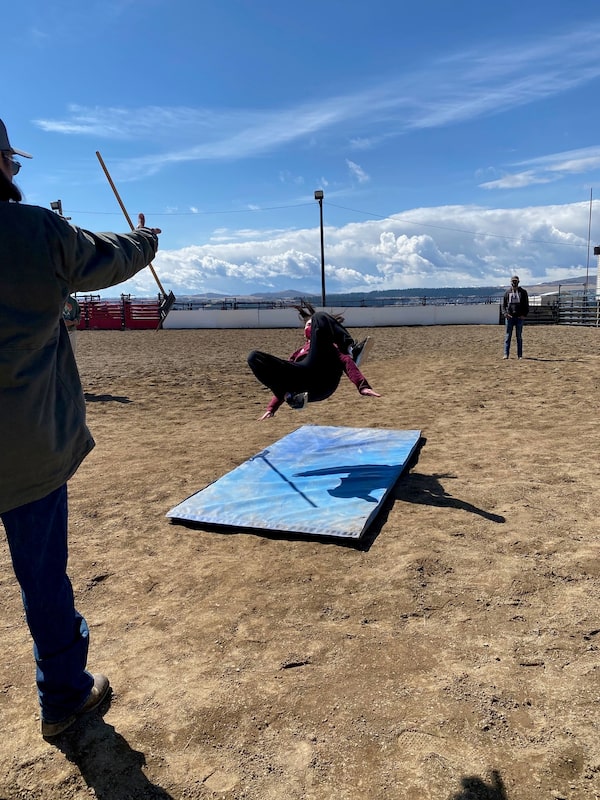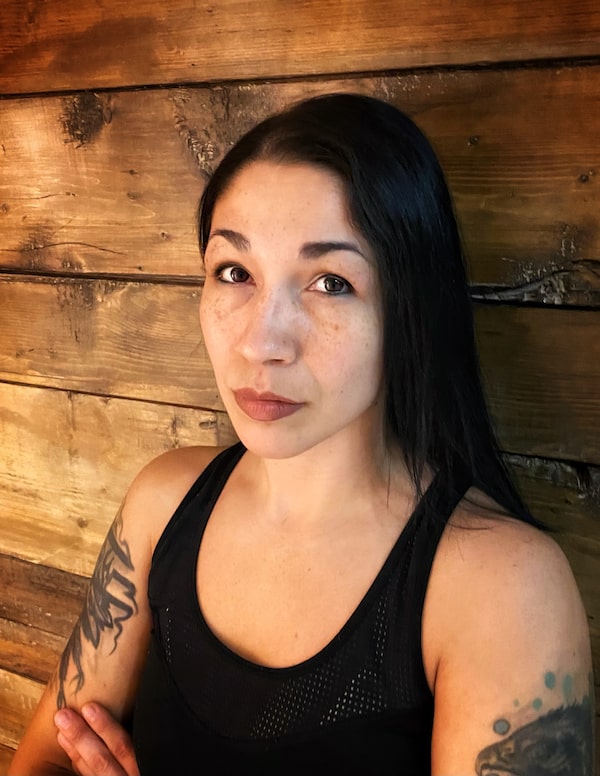
Rebekah Cardinal practicing being struck by an arrow at Stunt Nations workshop near Cochrane, Alberta, in May 2021.Stunt Nations/Handout
For decades, Marty Wildman watched white people perform stunts for Indigenous actors or, frequently, for white actors playing Indigenous characters on screen.
He would often find himself frustrated, thinking Indigenous people could do those jobs.
So he did something about it. He now offers a workshop for would-be stunt performers through Stunt Nations, a company he co-founded with actor Nathaniel Arcand, whom Mr. Wildman met when they were both cast members on the television series North of 60 in the 1990s.
Stunt Nations held its first workshop over two, two-day sessions this month at an arena near Cochrane, Alta., after getting a green light from provincial health authorities. All the training was done outdoors, with the participants – 18 in one workshop, 14 in the other – split into two groups to allow for physical distancing.
With more Indigenous people trained as stunt performers, the thinking goes, the less likely it will be that casting agents and directors will claim it’s difficult or impossible to hire them.
“They’re always saying, ‘Oh, we can’t find this guy, this guy has a specialty,’” Mr. Wildman said. “Well, why can’t we train these people?”
A similar initiative is under way in Vancouver, where long-time stunt performers Bruce Crawford and Lauro Chartrand-DelValle are planning a second workshop through the Indigenous Action Artist Mentorship Program on May 29 and 30.
IAAMP held its first workshop in February with backing from the Musqueam Indian Band. Eighteen participants learned some basic skills, including tips on what to expect on set and where to pursue more training in areas such as martial arts. (The Squamish and Tsleil-Waututh nations, as well as Stunts Canada, also provided support.)
Skylee Murray, who is Anishinaabe, attended the workshop in February and has already landed her first stunt credit, in the Netflix series Midnight Mass.

Skylee Murray, who is Anishinaabe, attended the workshop in February and has already landed her first stunt credit, in the Netflix series Midnight Mass.Handout
Ms. Murray had already been working in the industry, as a set painter, and is athletic, with some training in martial arts. In the workshop, she learned more about the varieties of stunt work available and the risks involved.
She didn’t want to give away too much about Midnight Mass, which has yet to be released, but said her role involved running and falling down – something she learned to do properly in the workshop.
More important than the technical skills were the connections she made with working industry professionals, she said, and the mentoring relationships the workshop offered.
“Each [participant] was connected with a couple of mentors … so we’re put in a position where we already get a whole bunch of people, and they’re actually here specifically to help us get referrals.”
Christopher Lambert and Aqqalu Meekis blocking and throwing kicks safely as they learn their fight choreography.Nick Marinos/IAAMP
Stunt workshops for Indigenous people reflects the burgeoning interest in and market for Indigenous stories and performances, both in Canada and abroad.
That interest extends to writing, directing and casting.
“In my early days of performing, I was often playing Native American performers, putting wigs on and stuff like that. But at least I have a brown skin tone – I’m half-Mexican, so I have an Indigenous background. But I often saw Caucasian stunt performers being made up as Indigenous and I just thought, ‘Where are the Native stunt performers? Why don’t we have any?’” IAAMP’s Mr. Chartrand-DelValle said in an interview.
“The opportunities are just not put in place for them, and they don’t know how to get into it,” he added.
The IAAMP workshop provides entry-level training – it keeps the risk level low while giving participants an idea of the additional skills they might want to learn.
Olivia Lucas learning the fundamentals of film fighting.Nick Marinos/IAAMP
“The fundamental skills are fighting and falling down – and doing that safely,” Mr. Crawford said. “But certainly, [stunt work] can be anything from car chases to explosions, wire work, fire work, horses, motorcycles – you name it. The stunt performers and co-ordinators – we help design and perform the action that the script calls for. We help the director facilitate that vision and make it come alive.”
Mr. Wildman, who got his start in stunt work largely through his horseback-riding expertise, said workshop participants can expect to learn to fall off horses and other skills.
For Ms. Murray, her stunt work education is just beginning, but she’s hopeful she will add other credits – and physical feats – to her resumé.
“There’s something for everybody, because our job, as stunt performers, is sometimes just doubling. And actors come in all shapes and sizes.”
Charles Harkey and Darnell Campbell getting hands-on instruction from Lauro Chartrand regarding punching techniques for film fighting.Nick Marinos/IAAMP
Our Morning Update and Evening Update newsletters are written by Globe editors, giving you a concise summary of the day’s most important headlines. Sign up today.
 Wendy Stueck
Wendy Stueck